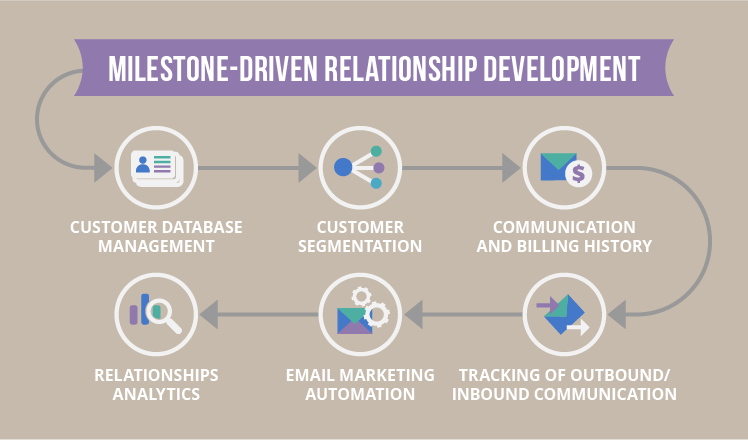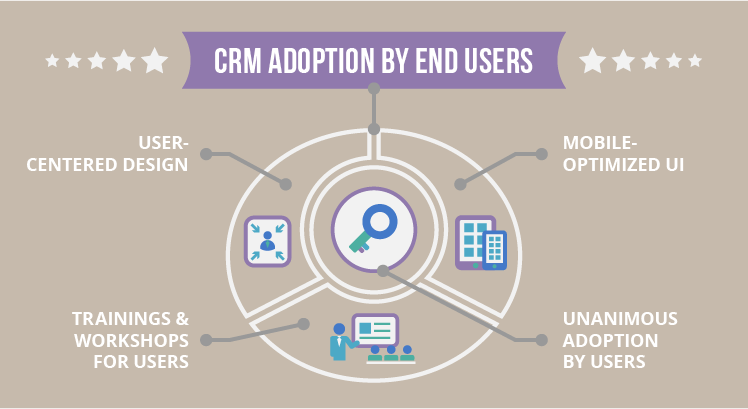How to energize long cycle sales using CRM
We feed on our CRM maturity model and revisit the ideas behind its first 3 levels to come up with the approaches and must-have CRM elements to energize specifically long-cycle sales the ones that take up to 3 years to occur. This is typical for selling highly technological solutions to public and private sector organizations in Defense, Aerospace, Transport, Oil & Gas, etc. So how can their vendors win it by using CRM tools?
CRM maturity is key
In our practice, we identify 4 CRM maturity levels that reflect the depth and efficiency of CRM adoption at B2B enterprises. This model reflects the progress from electronic record-keeping (Level 1) through all-round communication management (Level 2) to milestone-driven relationship development (Level 3) and strategic relationship management (Level 4).
For high-tech companies with long-cycle sales, it's critical to reach Level 3 step-by-step customer relationship development that makes it a must for salespeople to cooperate towards the relationship milestones specific for particular opportunities and customers to stimulate new contracts. At this stage, a CRM system would carefully track the dynamics of this progress over prolonged periods and align required activities with the sales force's productivity goals.
Such gradual progress would also cover all the important stages of CRM maturity that enable, from down to top:
- Customer database management
- Customer segmentation
- A single view of communication and billing history
- Tracking of outbound/inbound communication
- Lead nurturing and email marketing automation
- Relationships analytics

Level 3 is where a CRM system can bring a balanced value when utilized deeply with high adoption rates among the system users (primarily, sales representatives and managers). What's the result? As mature as this, your CRM will eliminate any instance of missing a single strategic activity that could otherwise spoil a-few-years-worth relationship development.
To illustrate the point, we provide particular techniques for reaching the 3rd CRM maturity level below.
Tip 1: integrate presales in CRM
Long sales cycles can be well explained by the high complexity and diversity of products and services on offer. Decision makers from the above-mentioned industries are no school folks, and they require ultimate competence from their vendors-to-be. To showcase it, you don't have to go to great lengths if you literally have the pool of technical experts mingling with your sales forces, albeit in a virtual space of your corporate CRM system, and helping them with specific tech-related questions
Integrating presales functions with sales processes will make your CRM a cross-collaboration point for the specialists engaged in presales activities (e.g. responding to RFPs, preparing demos, etc.). Each of them would have access to opportunities' profiles to source important information with no need to shuffle emails and attachments that could be easily lost or overlooked in busy inboxes.
Tip 2: automate lead nurturing
Advocating the role of CRM in lead nurturing is beyond the scope of this article, but those who doubt it may want to refer to Sid Smith's expert response on MarketingProfs. In our CRM consulting practice, we accept it as a given.
In the case of long-cycle sales, automation can help to sustain prolonged periods of lead nurturing and customer re-engagement via timely and effective communication.
Lead nurturing automation will bring structure and rhythm into nurturing activities. Through custom workflows and a system of automated alerts to assigned salespeople, it will assist in keeping up with the corporate lead nurturing strategy, which should define time intervals and communication policy. If multiple salespeople work on the same account, their activities will get synchronized and registered in comprehensive CRM profiles for leads, opportunities and customers.
Lead nurturing automation can also be extended to introduce custom rules for timely identification of communication gaps in lead nurturing processes, as well as custom reports on their progress and results.
Tip 3: raise CRM adoption rates
The success of any CRM project depends on its adoption by end users. Without unified, engaged and proactive participation from sales managers' side, such project is likely to fall short of accomplishing its goals.

First, the CRM's functionality should correctly reflect and support sales processes as it affects the quality of entered data and sales force's work efficiency. This would require CRM consulting and customization to make the system convenient: enable intuitive, highly usable interfaces, rapid data processing, availability of shortcuts and automation of manual routine (e.g. synchronizing emails, scheduling appointments, following up meetings, etc.).
Second, the mobile UI has to meet expectations. As mobile CRM users will be visiting customers on premises, the speed and quality of the data displayed on a mobile screen should not affect their performance. This should include adapting frequently used forms to mobile screens with only a careful selection of fields visible instantly and the rest hidden under separate tabs.
Third, eliminating users' technological ignorance raises buy-in rates, so it should be a requirement for CRM users to attend training sessions and workshops after the system is deployed. The goal would be to gain an understanding of how CRM can contribute to salespeople's daily work with a detailed explanation of its relevant functionality.
And finally, unanimous adoption by users is key, and identifying poor CRM adopters should also be on the agenda. Those sales representatives or managers who are not ready or willing to use the system diligently would be impeding their colleagues' work and reducing the impact. Therefore, it is likely to result in filtering the sales team to leave only those who comply with the new CRM policies and parting with others.
Conclusion
Selling highly technological, complex solutions won't happen in the blink of an eye. In extreme cases, it can take years, and, want it or not, your CRM system has to accommodate it. As a CRM consulting company, we have worked for over 8 years to define the CRM maturity model for effective customer relationship management, and now we revisited it in terms of addressing the complexity of vendors' offering, sustaining long-term nurturing and raising CRM user adoption rates.
For more details on CRM consulting and customization for your business, please contact us at contact@scnsoft.com.

